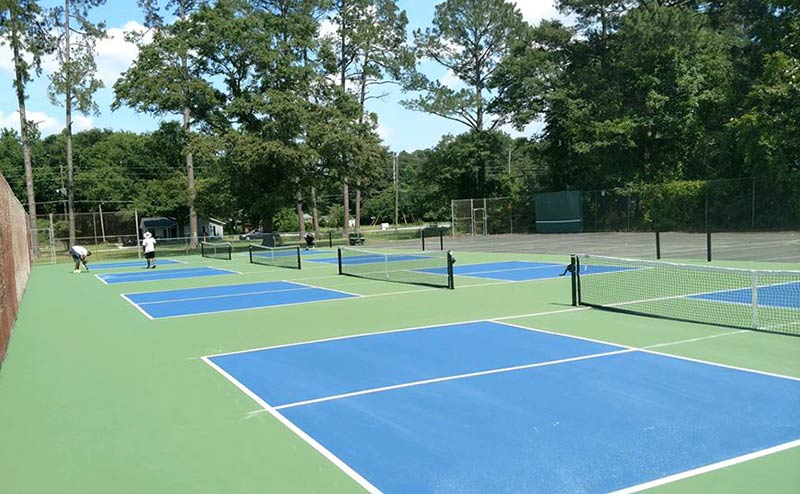Top Quality Pickleball Court Construction for Every Degree of Play
Top Quality Pickleball Court Construction for Every Degree of Play
Blog Article
Lasting Practices in Pickleball Court Building And Construction You Ought To Know
As the popularity of pickleball proceeds to climb, so also does the demand for sustainable techniques in court building and construction. The effect of these practices expands much beyond the court itself.
Picking Eco-Friendly Materials
Choosing eco-friendly products is an essential action in the construction of lasting pickleball courts. The selection of lasting materials not only decreases ecological impact however likewise boosts the durability and efficiency of the court. Key products consist of recycled rubber for the surface area, which provides exceptional longevity and shock absorption while drawing away waste from landfills.
Furthermore, utilizing in your area sourced materials lowers transportation emissions and sustains local economic situations. Pickleball court construction. For instance, using indigenous hardwoods for secure fencing and seats can provide a lasting aesthetic while making sure durability against the elements.
Including permeable materials for court structures can further add to sustainability by enabling all-natural water drain and reducing drainage. These options not just safeguard local ecosystems yet likewise advertise much healthier play environments.
Effective Drain Solutions
While the option of environment-friendly products is important, carrying out reliable water drainage services is similarly vital for maintaining sustainable pickleball courts. Correct drainage not just safeguards the court surface from water damage but also minimizes erosion and overflow, promoting ecological integrity.
Effective drain systems can include absorptive paving, which enables water to penetrate the ground instead of merging externally. This decreases the possibility of standing water, which can lead to mold and other upkeep concerns. Additionally, incorporating purposefully placed drain networks and swales can direct excess water away from the court location, making sure a completely dry playing surface and stopping dirt disintegration.
Using indigenous greenery in the landscaping around the courts can better improve water drainage by taking in excess water and lowering runoff. These plants require much less watering and advertise biodiversity, lining up with lasting techniques.
In addition, it is vital to routinely keep the water drainage system to guarantee its long-lasting effectiveness. This includes clearing debris and tracking for blockages. By prioritizing efficient water drainage options, pickleball court fabricators can significantly contribute to the sustainability and durability of the center, inevitably profiting both gamers and the atmosphere.
Energy-Efficient Illumination Options
As the need for pickleball remains to grow, integrating energy-efficient illumination options right into court layout has ended up being increasingly important for sustainability. Typical lighting systems typically consume excessive energy, contributing to higher operational costs and environmental influence. Consequently, taking on modern-day, energy-efficient technologies is crucial for both new constructions and improvements.
LED (Light Emitting Diode) lights stands apart as a premier option because of its longevity and power financial savings (Pickleball court construction). Compared to traditional lights, LEDs make use of roughly 75% less energy and can last approximately 25 Get More Information times longer, considerably minimizing upkeep costs. The directional nature of LED illumination minimizes light air pollution, making sure that illumination is concentrated on the court rather than surrounding locations.

Lasting Surface Area Alternatives
Discovering lasting surface area choices for pickleball courts has gotten traction among players and contractors alike. The emphasis on eco-friendly products not just straightens with the expanding ecological awareness but likewise enhances the performance and longevity of the courts.
One preferred choice is using recycled rubber, which can be sourced from made use of tires. This material provides exceptional shock absorption, reducing the risk of injuries for gamers while promoting sustainability. In addition, modular floor tiles made from recycled plastics provide one more feasible option. These floor tiles are simple to install and replace, and their adaptability permits for various court setups.
All-natural turf courts are also becoming a lasting option, advertising biodiversity and decreasing the warmth island result. However, they require regular upkeep and water, which may not straighten with all sustainability goals.

Water Conservation Methods

One more efficient technique includes the installation of rainwater harvesting systems. These systems store and accumulate rainwater for use in keeping court surface areas and landscaping. This technique not just conserves potable water however also minimizes dependence on metropolitan resources.
In addition, employing drought-resistant landscaping around the courts is vital. Indigenous plants need much less water and here are the findings are better adapted to neighborhood climate conditions, hence reducing general water intake. In addition, utilizing reliable irrigation systems, such as drip irrigation, ensures that water is delivered straight to plant roots, lessening evaporation and waste.
Final Thought
Integrating lasting techniques in pickleball court construction dramatically contributes to ecological preservation and resource efficiency. By focusing on these techniques, the building and construction of pickleball courts can align with more comprehensive environmental goals while advertising long life and performance within areas.
As the appeal of pickleball continues to increase, so too does the demand for sustainable techniques in court building.Picking eco-friendly materials is an essential action in the building and construction of sustainable pickleball courts. By focusing on energy-efficient illumination choices, pickleball court producers can add to a more lasting future while satisfying the demands of stakeholders and players alike.Including lasting surface alternatives not only enhances the efficiency of pickleball courts but additionally leads the means for carrying out reliable water conservation strategies.Integrating lasting practices in pickleball court construction dramatically contributes to ecological preservation and source performance.
Report this page